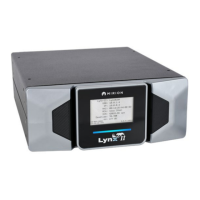Chapter 1 Introduction
6 Lynx II DSA User's Manual - 7096089
MCS and PHA acquisitions are independent of each other. Spectrum data and elapsed
dwell values are stored in persistent memory, meaning that cycling power to the Lynx II
will abort any acquisition in progress but will not lose data already accumulated.
MCS acquisition always begins at spectrum channel #1 and progresses linearly through
the end of the spectrum, accumulating the residual data from previous sweeps.
MSS Mode
The MSS (Multispectral Scaling) mode, also called “ping-pong” mode, alternately
collects PHA data in two separate memory groups based on a preset condition,
collecting many spectra with extremely low latency between acquisitions. Spectra are
stored internally along with their acquisition times until requested and/or consumed by
the client application.
Input #1 must be set for MSS mode. Acquisition is automatically directed into both
memory groups.
In MSS mode, the Lynx II can be set to automatically stream (or push) data out to
listening clients at the completion of each acquisition cycle or can be set to concatenate
spectra in its internal buffers until requested by the client, or buffers run out. If data is
not requested and buffers run out, the current acquisition cycle will be extended to
prevent data loss.
If using MSS mode through a custom application, please see the important note in
Using the Programming Libraries on page 7.
List Modes
The Lynx II supports Standard List Mode (LIST), and Time-Stamped List Mode
(TLIST). Input #1 must be set to the appropriate mode to enable List mode.
In Standard List mode, each energy event is digitized by the PHA digital processor and
temporarily stored in a buffer memory, one word per event, until requested and/or
consumed by the client application.
Time-Stamped List Mode is similar to Standard List Mode, however, each energy event
is tagged with the time of arrival. Both the energy and time are temporarily stored in a
buffer memory, one word per event, until requested and/or consumed by the client
application. The resolution of the time stamp can be set to 100 or 1000 nanoseconds.
List data stored by the Lynx II in its temporary buffers can be read using the Lynx II’s
Programming Libraries and energy and time-correlated spectra can then be created from
the data by custom applications.
In List Mode, the Lynx II can be set to automatically stream (or push) data out to
listening clients at fixed periodic intervals or can be set to retain list data in its internal
buffers until requested by the client. If data is not requested and buffers run out,
eventually new data will be lost.
If using List or time-stamped List mode through a custom application, please see the
important note in Using the Programming Libraries on page 7.

